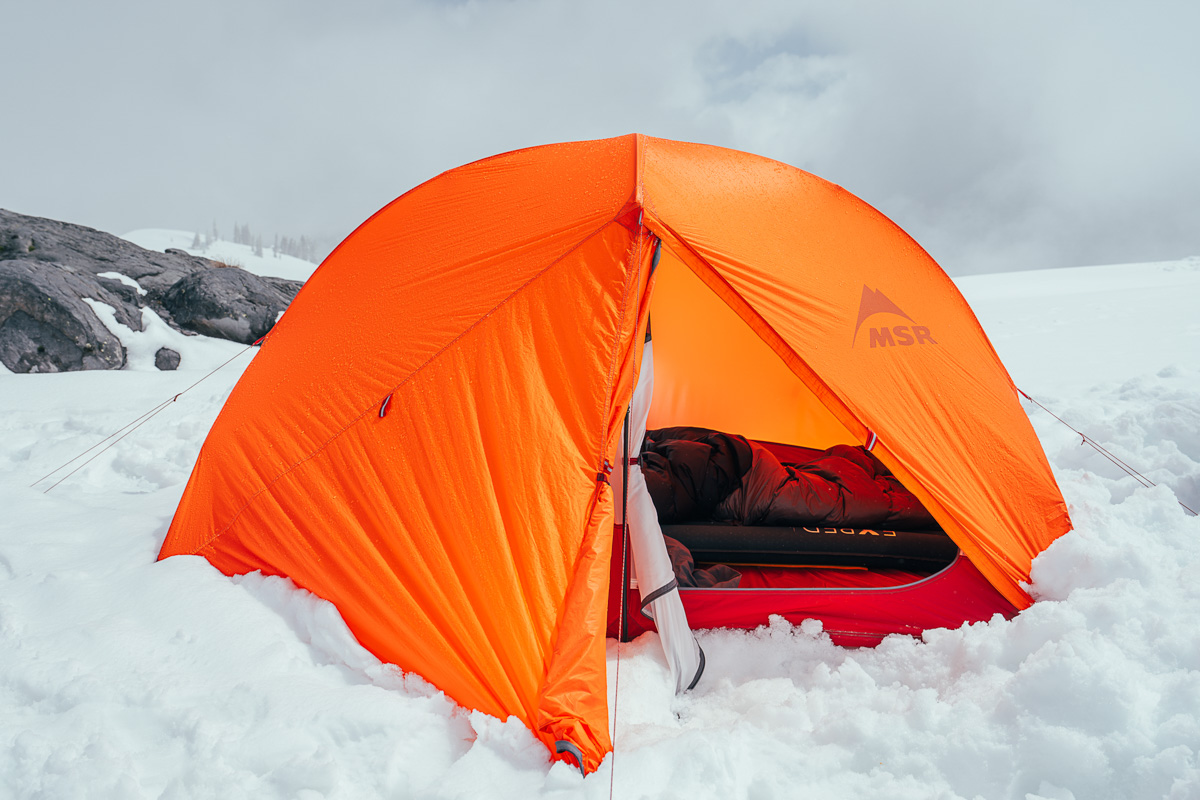
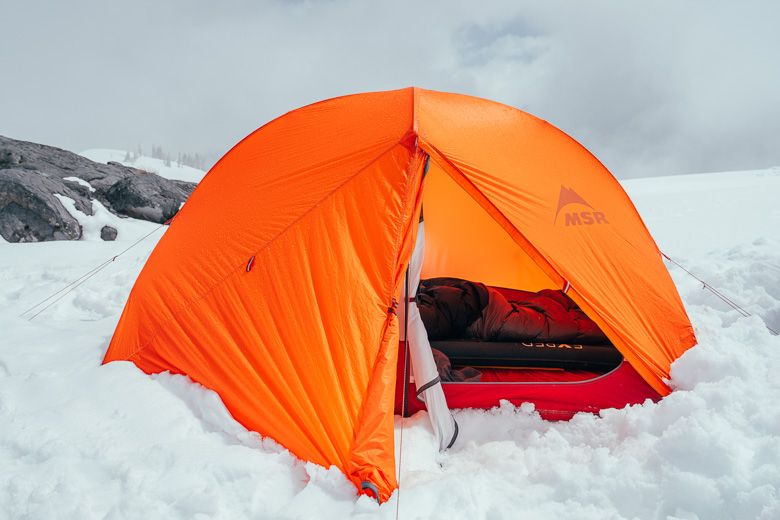
Price: $800
Packaged weight: 4 lb. 1.0 oz.
Floor area: 29 sq. ft.
Wall(s): Double
What we like: Lightweight, weather-ready, and easy to set up—great for solo winter campers who won't be venturing above treeline.
What we don’t: Thin fabrics, limited ventilation, and a tight squeeze for two.
See the MSR Access 2
Toeing the line between a 3- and 4-season tent, MSR's Access is well suited for fast-and-light backcountry missions that warrant the added protection but without the heft and bulk of a true mountaineering design. I pushed the tent a bit beyond treeline during a May ski tour on Mount Rainier and was impressed by how well it held up in the stormy conditions we faced on the glacier. Its mostly nylon body offers great heat retention on cold nights (at the sacrifice of some ventilation) and is a breeze to set up and take down. Sharing the two-person model with a partner was a bit of a squeeze, but overall, the tent nicely balances weight, roominess, and durability. Below are my thoughts on the Access 2. To see how it stacks up to the competition, check out our articles on the best 4-season tents and the best backpacking tents.
MSR lists the Access 2 as a 4-season tent ideal for less severe conditions (like those you might encounter at treeline), meaning it falls short of true mountaineering designs when it comes to all-out protection but offers a step up compared to standard backpacking tents. That said, I felt comfortable pushing the tent a bit beyond treeline on a few May ski touring missions on Mount Rainier. Spring conditions on the mountain can shift from sunny and warm to wet and windy in a matter of hours, and I was impressed with how well the Access 2 held up to everything Mother Nature threw its way.
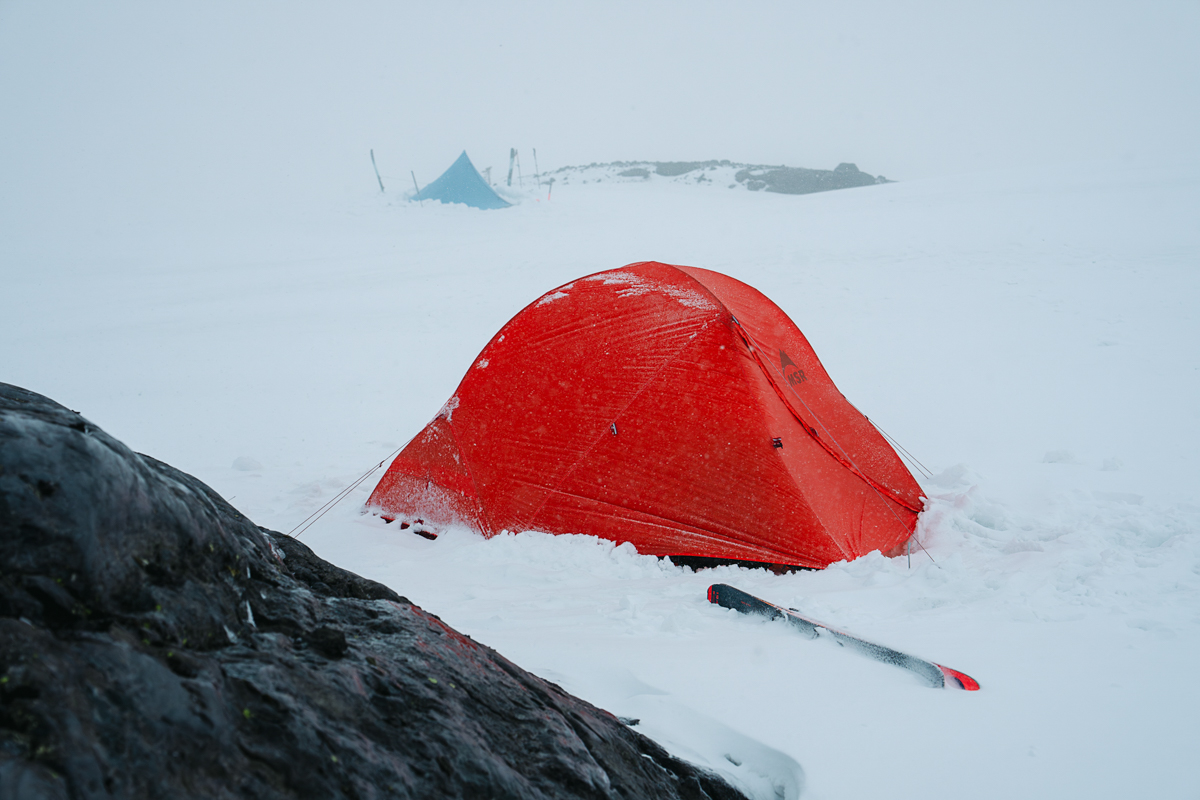
Wind
Both of my Mount Rainier attempts were met with periods of consistent gusts between 30 and 40 miles per hour. While I was initially worried that the tent poles wouldn't be able to hold up (I've had MSR poles snap in blustery weather in the past), the Access' Easton Syclone poles held up extremely well to the the blasts. That said, calling them rigid would be an overstatement—they bend considerably in strong gusts, which causes the tent to move, too. In the end, it wasn't the most comfortable experience waiting out extended storms, but the poles' flexibility kept them from snapping, which is the more important consideration.
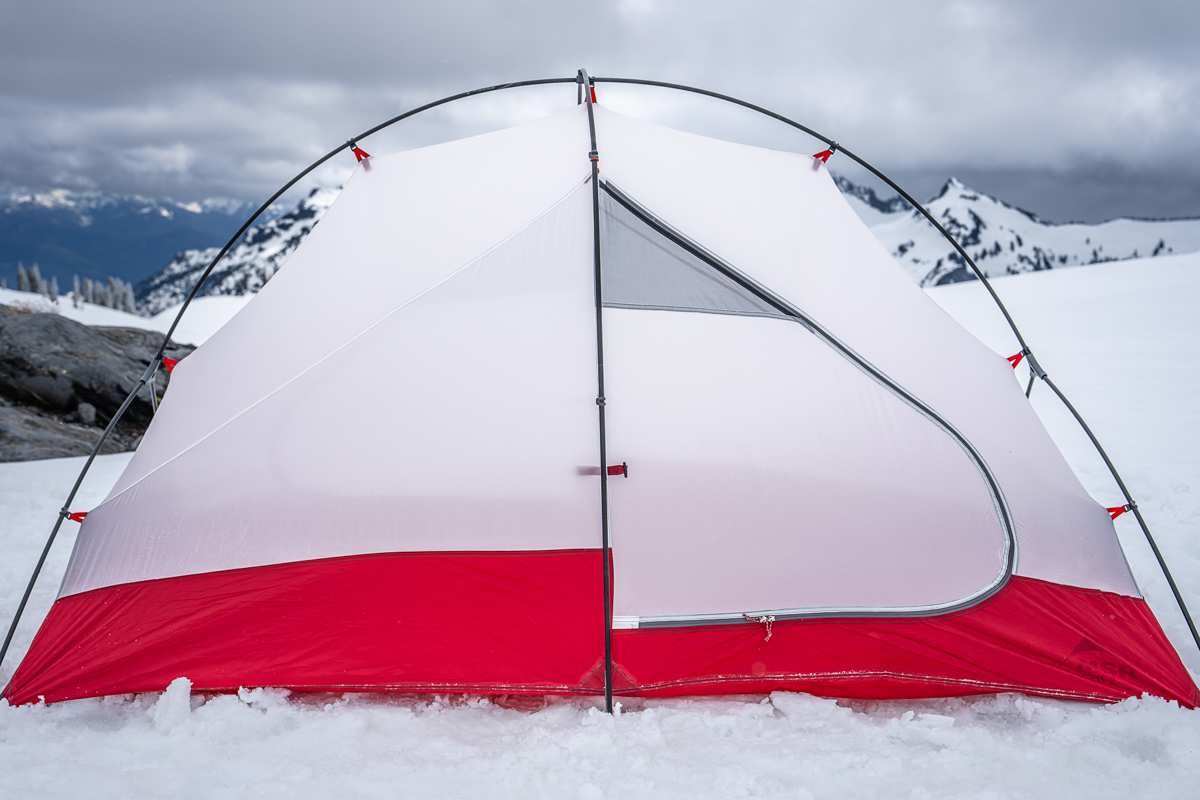
However, I did have issues with wind blowing snow underneath the rainfly. Unlike many other 4-season tents—especially those built for true mountaineering objectives, like MSR’s own Remote 2— the Access 2’s fly doesn’t extend all the way to the ground, leaving a few inches of single-wall fabric exposed at the bottom. This resulted in snow making its way inside the tent when the wind picked up, leading to a damp interior. To be fair, building a snow wall helped mitigate the issue, but those heading into the alpine may want to upgrade to a more weather-worthy option like the Remote, which has a full-coverage fly.

Snow
The Access' ripstop nylon rainfly and floor provided excellent protection against moisture. While MSR claims the central support frame should prevent snow loading, the sticky and wet springtime snow we faced on Mount Rainier was quick to collect along the sides of the tent. Despite this, the frame held the weight without collapsing (MSR states it can hold up to 27 lb.). The rainfly and floor fared similarly well, never wetting out despite the melting snow. Importantly, both the fly and floor are treated with polyurethane and a durable water-repellent (DWR) finish, and the canopy also has a DWR coating—all of which did their job, causing moisture to bead up and roll off the tent's exterior.
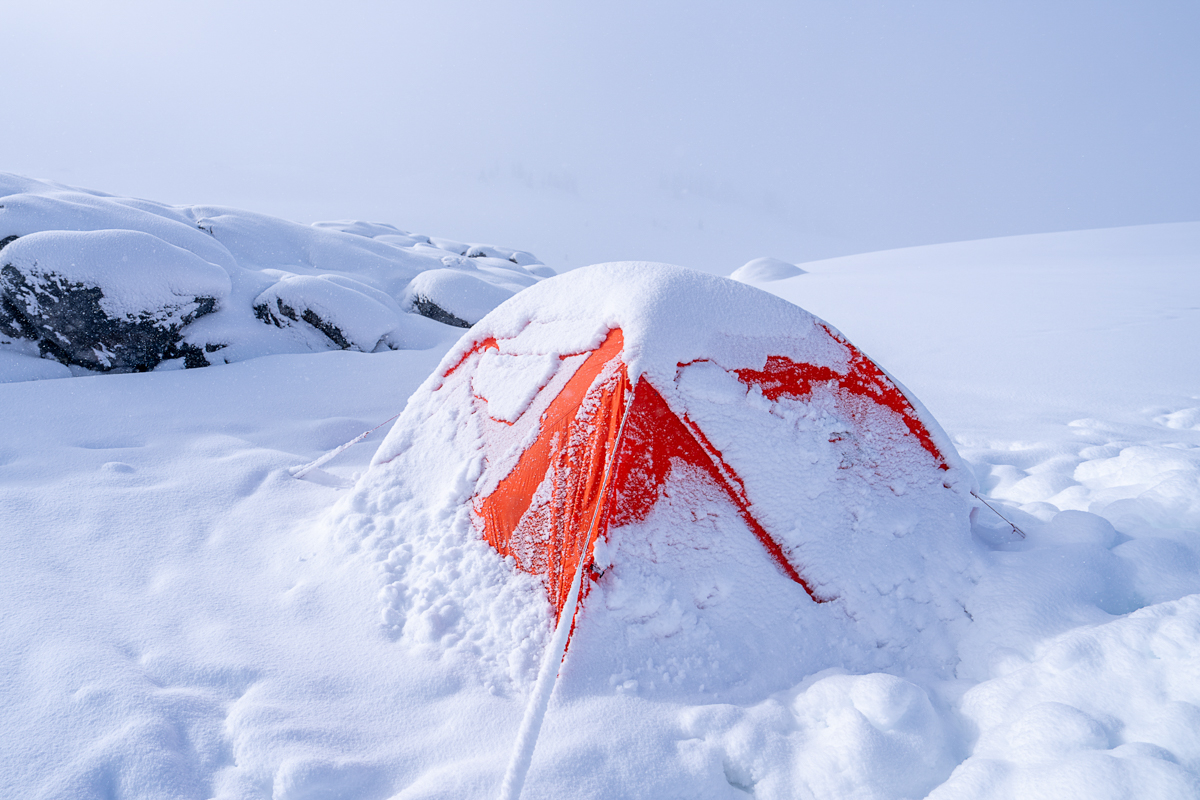
I opted for the two-person MSR Access to give myself some extra room on ski mountaineering missions. The 29-square-foot floor area provided enough room for my overnight camping setup—including a cold-weather-ready sleeping pad and sleeping bag— with room to spare, and the 42-inch peak height was tall enough that I was able to comfortably change clothes and sit up on my pad. On the outside, two 17.5-square-foot vestibules provided sufficient room for my mountaineering pack, ski boots, and other gear I wanted to keep separate.
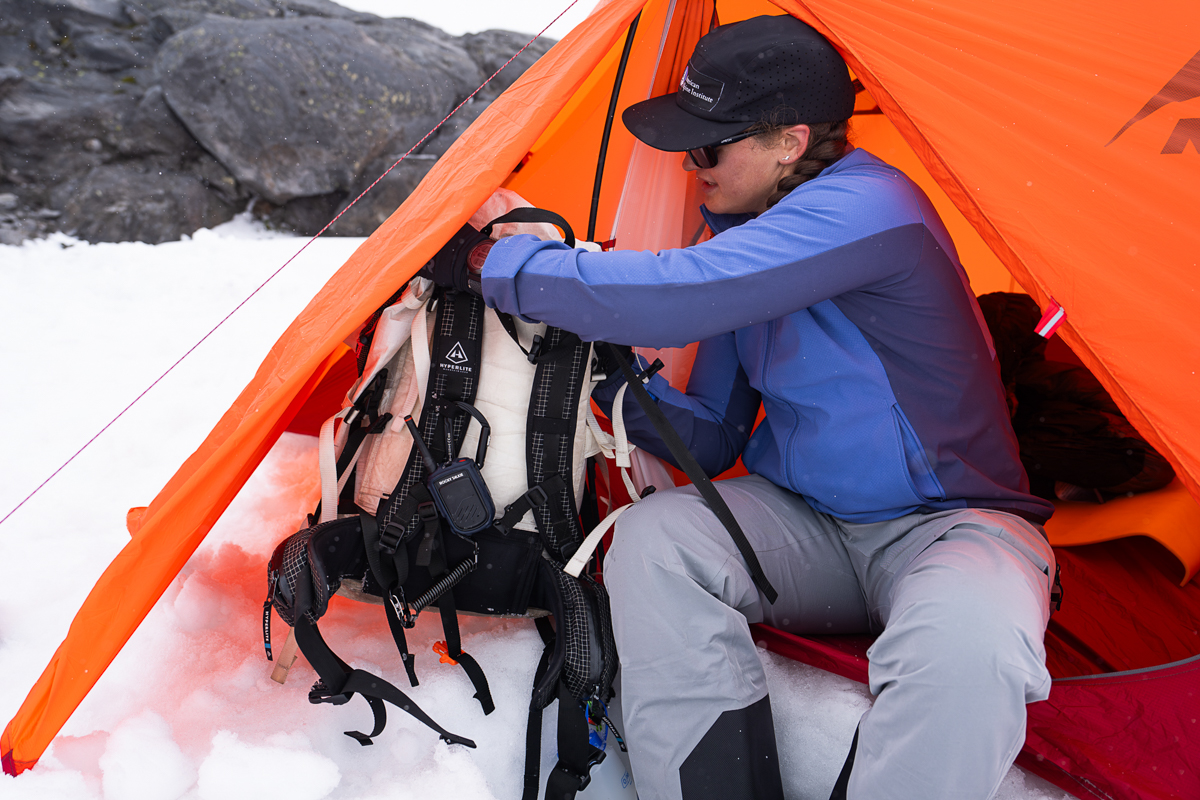
Unfortunately, it was a different story sharing the tent with a partner. For reference, I am around 5'8", and my partner is much taller at 6'3". His height spanned close to the full length of the tent (84 in.), preventing him from being able to store any gear at his feet. What’s more, the sloping walls reduce overall headroom (only the very middle is 42 in.). While I was able to scoot down a few inches to create space between my pad and the tent wall, my partner’s head was touching the wall throughout the night. Snow buildup during storms only exacerbated the issue. As a result, his longer sleeping pad and bag were more prone to collecting moisture as they rubbed up against the condensation-ridden walls. On the plus side, we did enjoy the convenience of two doors (especially for bathroom breaks) and being able to split up our gear into the two vestibules (digging pits allowed for more storage space in each).
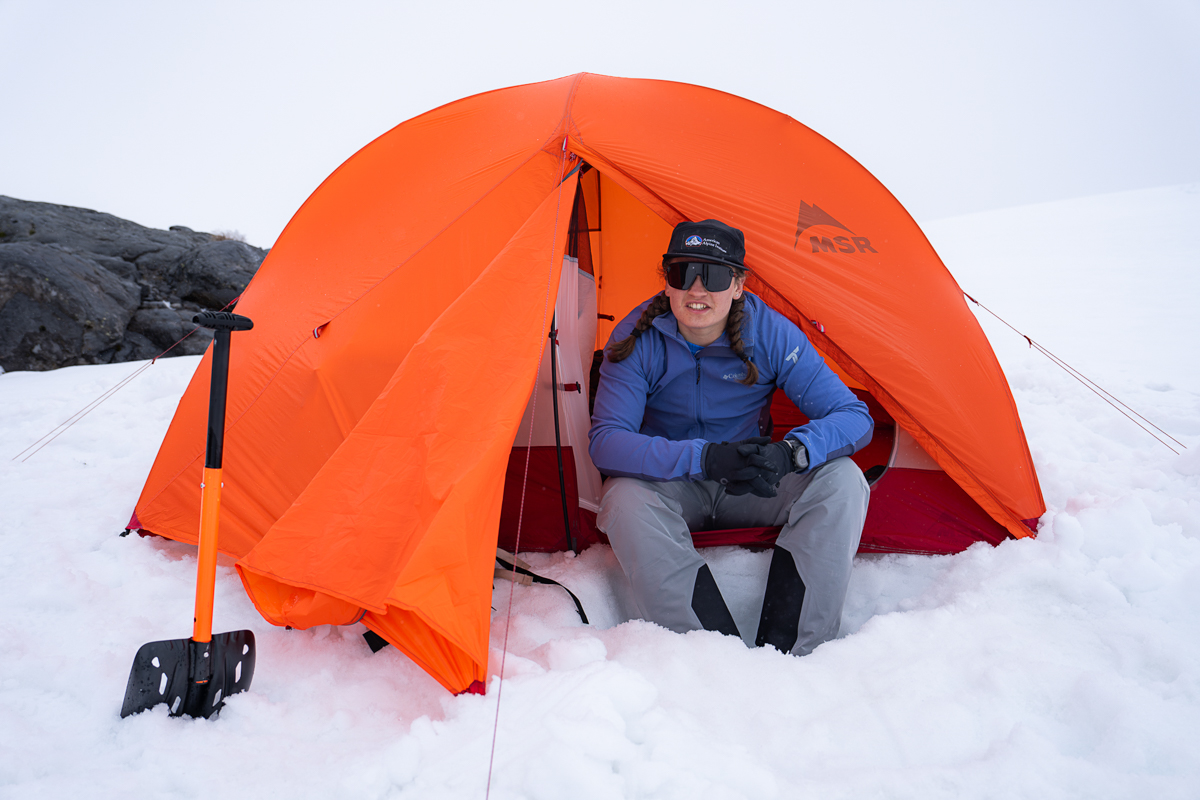
The Access 2 checks in at 4 pounds 1 ounce all in, which is competitively lightweight among other treeline-oriented 4-season tents. For comparison, Nemo’s similarly intentioned Kunai 2P is a little heavier at 4 pounds 5 ounces while featuring only one door, one vestibule, and smaller floor area. REI Co-op's budget-friendly Arete ASL 2 is even heavier at 6 pounds 5 ounces, but it does feature a larger interior and thicker fabrics. Stepping up to a true 4-season tent will incur even more of a weight penalty, with options like MSR's own Remote 2 checking in at 7 pounds 2 ounces. In the end, the Access 2 does make some noteworthy concessions to keep weight and bulk to a minimum—including using thinner materials and a streamlined rainfly—but I feel MSR did a great job balancing the tent's priorities.
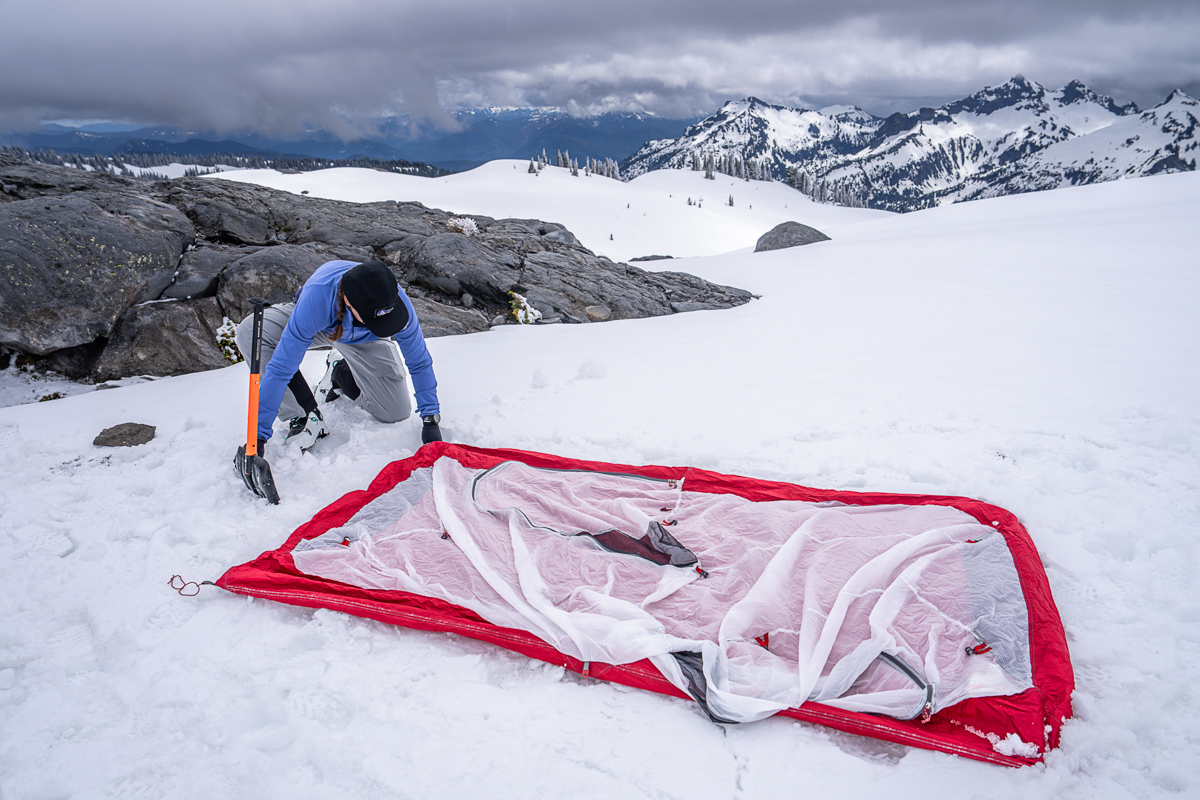
MSR claims the Access 2 packs down to 6 by 18 inches in its stuff sack, but I found it easier to separate the components to maximize space in my pack. Overall bulk was low compared to other 4-season tents I’ve used, which certainly helped me stuff the tent alongside other gear. However, I found the poles a bit challenging to slot inside: Unless I meticulously organized my gear, they were too long to fit inside my Hyperlite Headwall 55. At one point, I found it easier to just strap them to the outside to avoid the hassle.

I had a few concerns regarding the durability of the MSR Access 2 going into testing, including the reliability of the thin materials. This lightweight tent has a comparatively thin 30D floor and 20D rainfly, which leave it more prone to wear and tear than burly mountaineering designs (which typically feature 70D fabrics). In fact, the fly acquired a hole during its second use. To be fair, I haven't been overly cautious when using the tent, but I have taken standard precautions like avoiding packing it beside sharp gear. Ultimately, it's disappointing to see damage this early into testing. The floor has held up well so far, but I've only had the chance to test it on snow—and I'm not overly optimistic about camping on rocks or sharp forest debris.
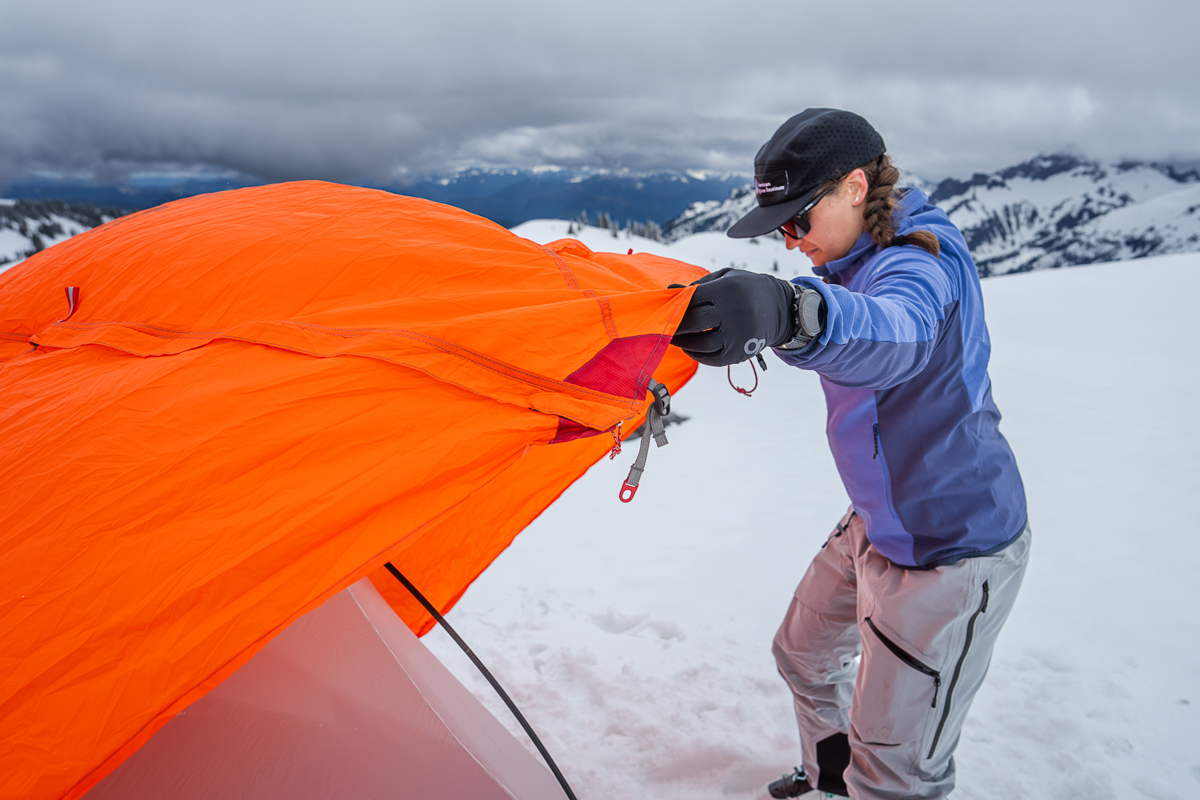
I was also initially concerned with the sturdiness of the Access 2’s poles, but they’ve since proved well equipped to handle high winds. MSR claims the Syclone poles are as light as aluminum and as strong as carbon, and I feel that description is accurate. My only remaining worry is the long-term durability of the plastic pole ends, which seem a bit flimsy and prone to breaking, although I haven’t experienced any issues yet.
The MSR Access 2 features a mostly nylon body that excels at trapping warmth on cold winter nights. While this was a much-appreciated feature when the sun went down, the tent was quick to heat up during the day, especially when exposed to high-altitude UV rays. The lack of ventilation contributed to the sauna-like conditions and caused a fair amount of condensation buildup during the night. There are a few small vents on the rainfly, but they require a guyline to prop open—I prefer tents with strutted vents for their convenience and ease of use. And even with the fly vents guyed out, I found I needed to crack the door to truly air things out. I admittedly didn’t spend much time inside during the day, so it wasn’t a major problem for me, but I imagine things would get—and stay—soggy should you need to wait out weather for extended periods.
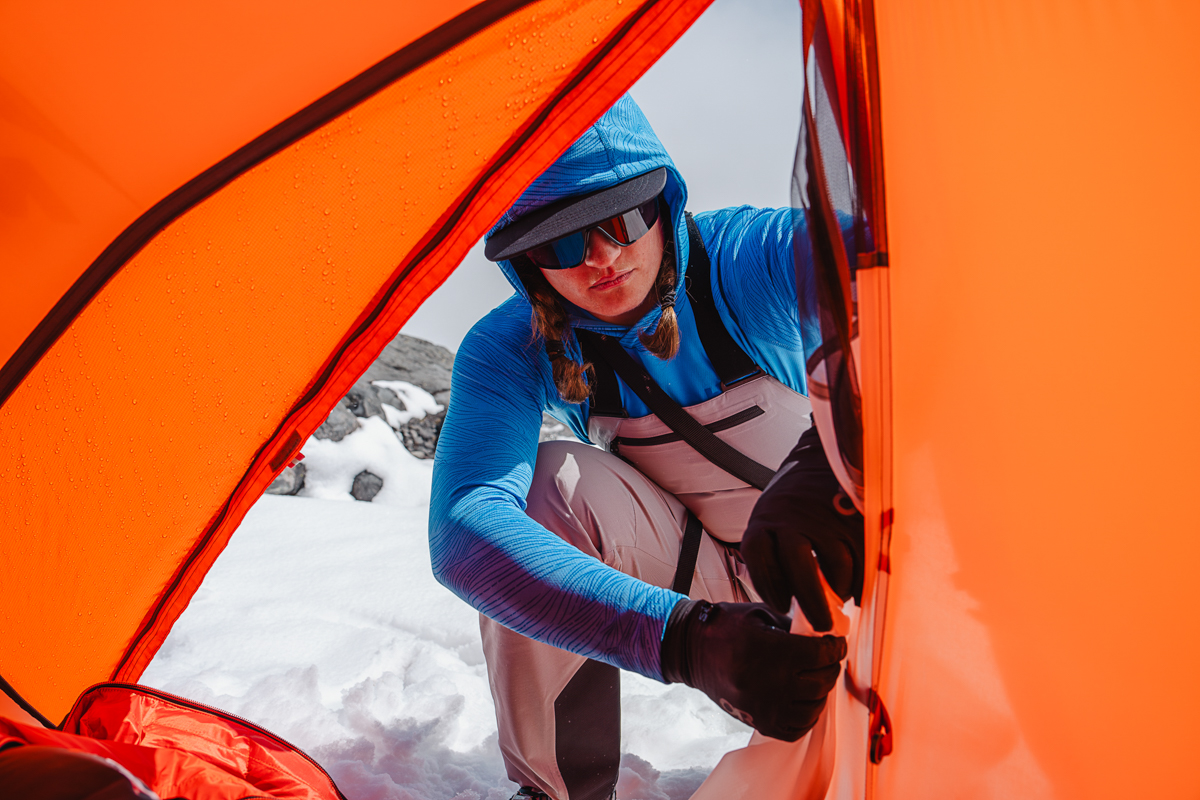
Simply put, the Access 2’s storage layout left me wanting more. When camping on my own, I was able to easily divvy up my gear between the vestibules and extra interior space, but sharing the tent required a bit more creativity. My partner and I found it easiest to dig deep holes in the vestibules so we could maximize our space (on my own, I split my backpack and boots between the two vestibules). The lack of interior pockets is also a bummer. There are just two shallow mesh pockets, which are large enough to fit an AIARE field book, a headlamp, and stuff sacks, but they filled up quickly when sharing the tent. In the end, I found myself wishing for a more generous layout, including at least one overhead pocket for easy access to small items in the middle of the night.
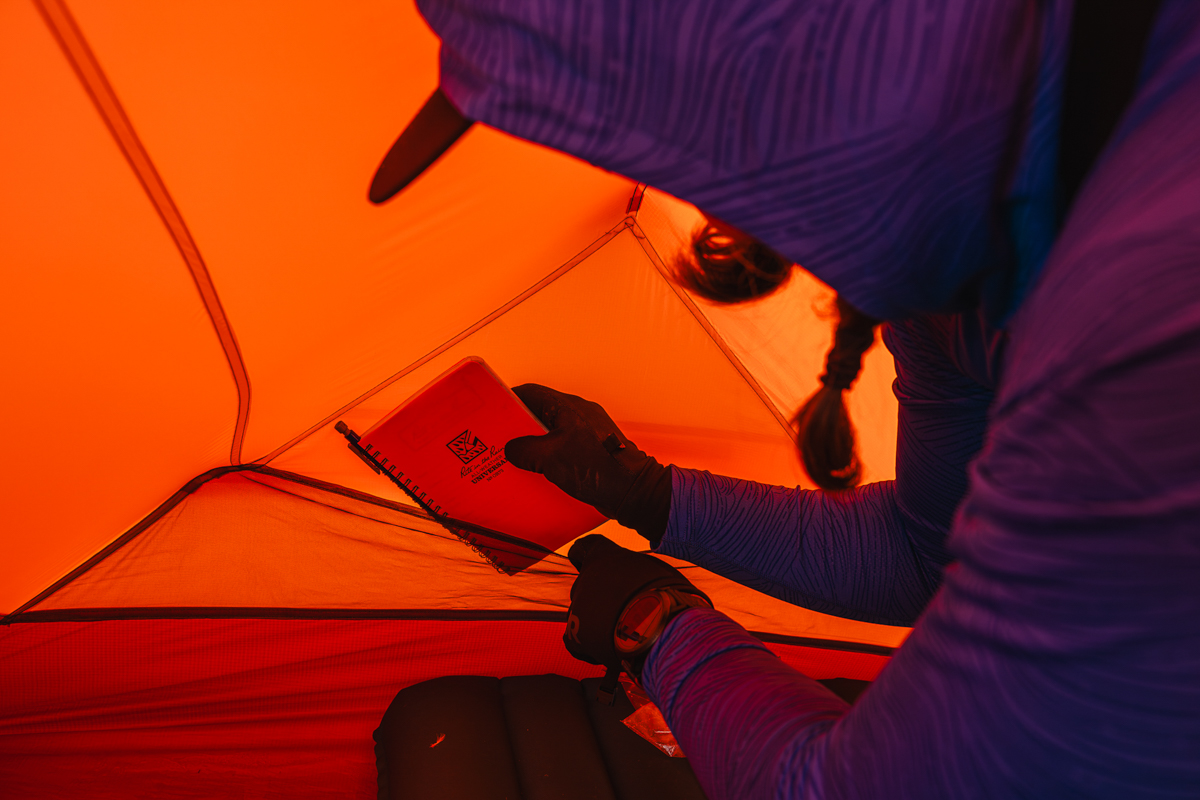
Setting up the Access 2 was a quick and easy process, even on my own. It helps that the poles are all connected, and the hubs make it easy to quickly create the structure, even with gloves on. Once the frame is assembled, the inner tent body connects via several plastic clips. The rainfly is easy to toss over the top of the tent and secure at the corners. The included Groundhog stakes (8) made it easy to secure the tent in snow, and I was able to adjust the length of the guylines without issue. Taking down the tent is equally simple, though as I mentioned, packing the tall poles did require some thoughtful organization inside my pack.
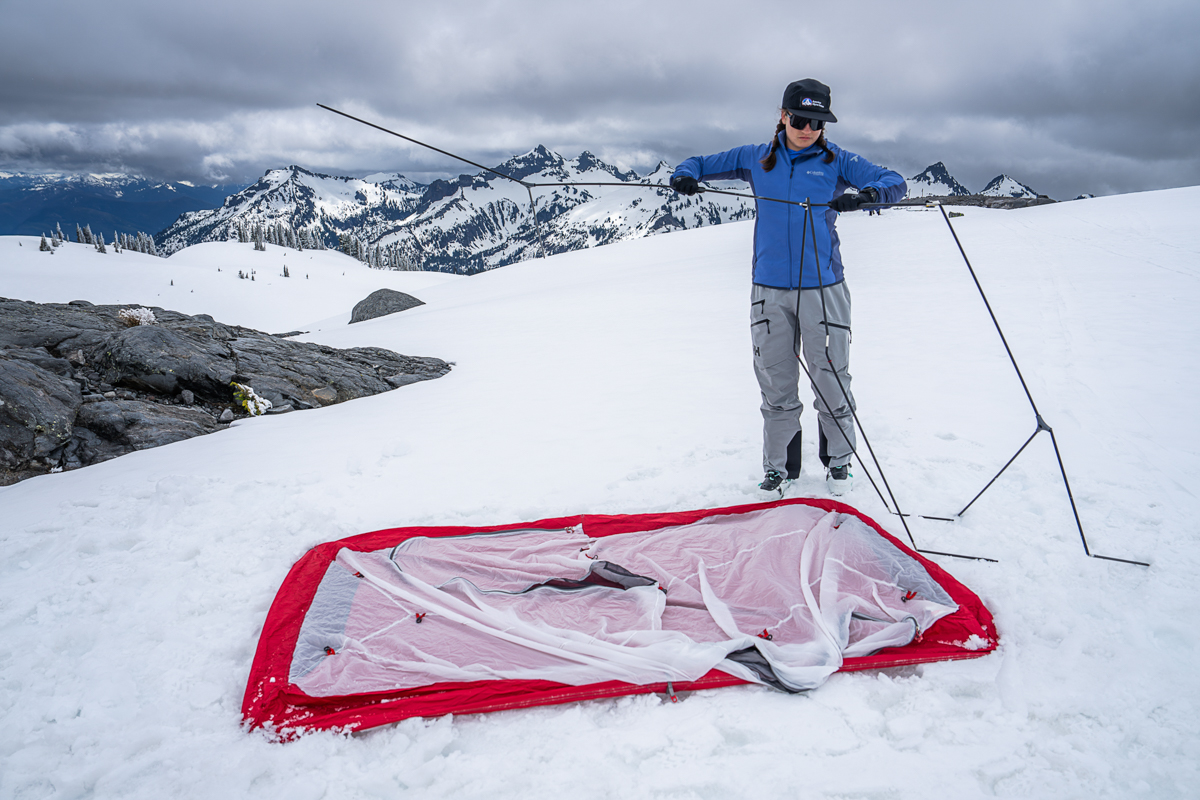
I tested the two-person version of the Access tent, and MSR also offers the design in one- and three-person capacities. Opting for the smaller Access 1 is a nice way to save weight (it has a packed weight of 3 lb. 8 oz.), although it's considerably smaller with a 19-square-foot interior, 40-inch peak height, and single-door-and-vestibule layout. In our opinion, the larger Access 3 is better suited for two people than the Access 2 with a nice boost in roominess (41 sq. ft.) and headroom (47 in. at the peak). For reference, two of our testers were able to fit themselves plus their medium/large dog inside a previous version of the Access 3, which had similar dimensions. You will pay penalties in both weight (5 lb. 1 oz.) and price ($920), but splitting the components up with a ski partner makes the three-person version still viable for fast-and-light missions.


| Tent | Price | Weight | Floor Area | Height | Floor | Door(s) |
|---|---|---|---|---|---|---|
| MSR Access 2 | $800 | 4 lb 1.0 oz. | 29.0 sq. ft. | 42.0 in. | 30D | 2 |
| Nemo Kunai 2P | $550 | 4 lb 5.0 oz. | 26.0 sq. ft. | 44.0 in. | 30D | 1 |
| REI Co-op Arete ASL 2 | $449 | 6 lb. 5.0 oz. | 32.9 sq. ft. | 43.0 in. | 70D | 1 |
| Hilleberg Allak 2 | $1,375 | 7 lb. 4.0 oz. | 30.1 sq. ft. | 41.3 in. | 70D | 2 |
| MSR Remote 2 | $860 | 7 lb. 13.0 oz. | 33.0 sq. ft. | 44.0 in. | 40D | 2 |
MSR's Access 2 has a lot going for it, but it's not the most competitive treeline-ready 4-season tent. One alternative we prefer is Nemo's Kunai 2P, which offers a step up in ventilation with a large overhead vent, strutted fly vents, and zippered mesh windows. When a storm rolls in, the Kunai is able to hold its own thanks to a sturdy pole structure and quality materials. It also features a taller bathtub floor that does a better job guarding against blowing snow. However, the Access does win out in a few areas: It's lighter by 4 ounces, has a 3-square-foot-larger interior, and features an additional door and vestibule. On the flip side, the Kunai is 2 inches taller at its peak and a whopping $250 cheaper, making it the better overall value.
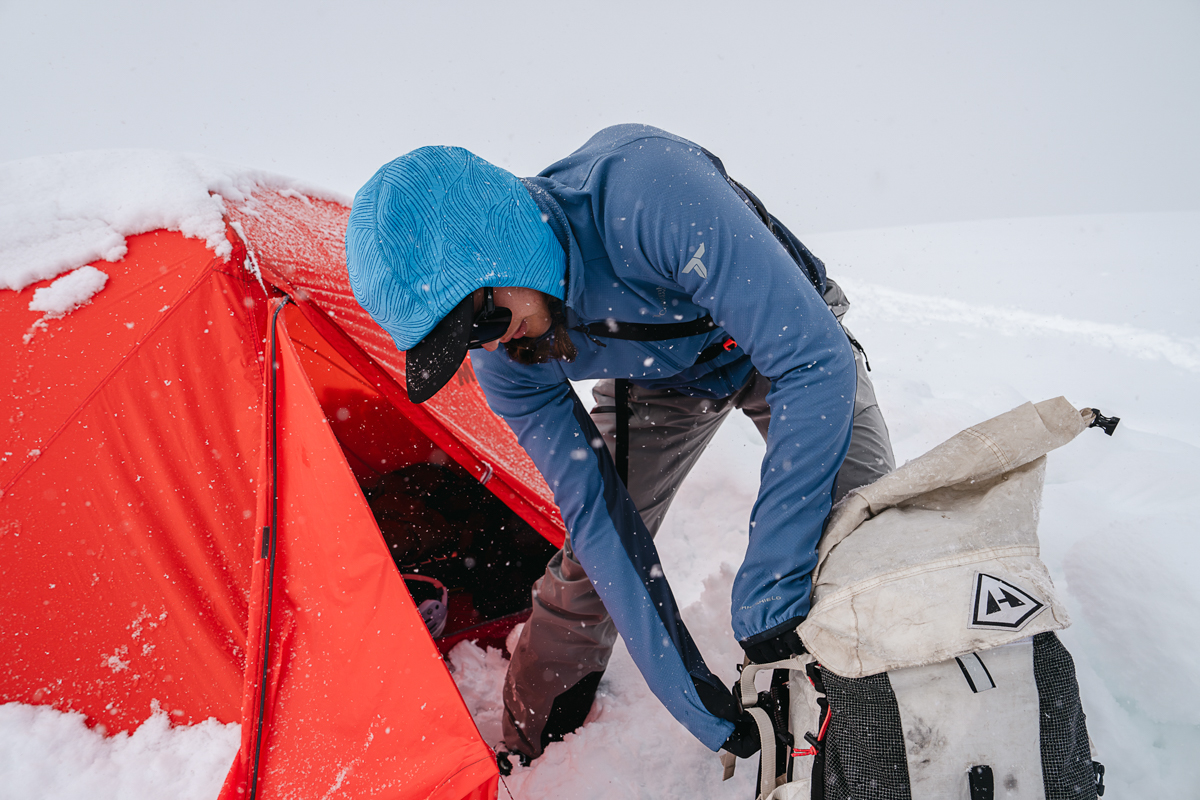
REI Co-op’s Arete ASL 2 is a more affordable double-wall treeline option to consider. For just $450, it features a thicker 40D rainfly and 70D floor, plus a spacious 32.9-square-foot interior, zippered mesh panels, and adjustable vents for better airflow. In testing, we found the REI well suited for camping with a partner: While the single door isn’t ideal, its foot-end placement allows for easier access, and the walls (which aren't sloped as aggressively as the Access') offer more headroom when sitting or lying down. The Arete isn't a strong performer in windy conditions—the tall build makes it vulnerable to gusts—but it's held up well to snow loading and steady rain. It's no featherweight at 6 pounds 5 ounces all in, but when split between partners, the Arete is entirely reasonable and will save you a good deal of cash over the MSR.
Sweden-based Hilleberg is known for its premium tents, and their Allak 2 is purpose-built to handle high winds, heavy snow, and harsh environments. With a thicker 30D fly and 70D floor, it offers solid protection against the elements and holds up well on abrasive surfaces. Like the Access 2, it features two doors and two vestibules, along with a slightly larger floor area (30.1 sq. ft.) but shorter (41.3 in.) peak height. However, the Allak is an even worse breather than the Access and fairly bereft of interior storage. At 7 pounds 4 ounces all in, it's also on the heavier end and far less appealing for fast-and-light missions. In the end, we don't feel the Allak's upgrades justify the $1,375 price tag, as most backcountry skiers will find the Access 2 entirely sufficient for mid-winter conditions in the Lower 48.

While we had success pushing the Access 2 beyond treeline in mid-spring conditions, MSR’s Remote 2 is better suited for true mountaineering missions. While heavier at 7 pounds 13 ounces, it compensates with a more durable build that includes a 40D canopy and floor and a 68D rainfly. Like the Access, the Remote uses quality Easton Syclone poles and a strong frame but is designed to withstand even wilder winds and heavier snow loading (though there's still a sizable gap between the ground and the fly). The Remote 2 also offers a slightly larger interior (33 sq. ft.) and roomier vestibules (19.5 sq. ft. each) for improved livability and storage space. Ventilation remains a weak point due to the lack of mesh, but for just $50 more than the Access 2, the Remote 2 strikes us as a solid upgrade for those venturing into high-altitude conditions.
If you’re thinking about buying gear that we’ve reviewed on Switchback Travel, you can help support us in the process. Just click on any of the seller links above, and if you make a purchase, we receive a small percentage of the transaction. The cost of the product is the same to you but this helps us continue to test and write about outdoor gear. Thanks and we appreciate your support!
Depending on the seller, most products ship free in the United States on orders of $50 or more. International shipping availability and rates vary by seller. The pricing information on this page is updated hourly but we are not responsible for inaccuracies.